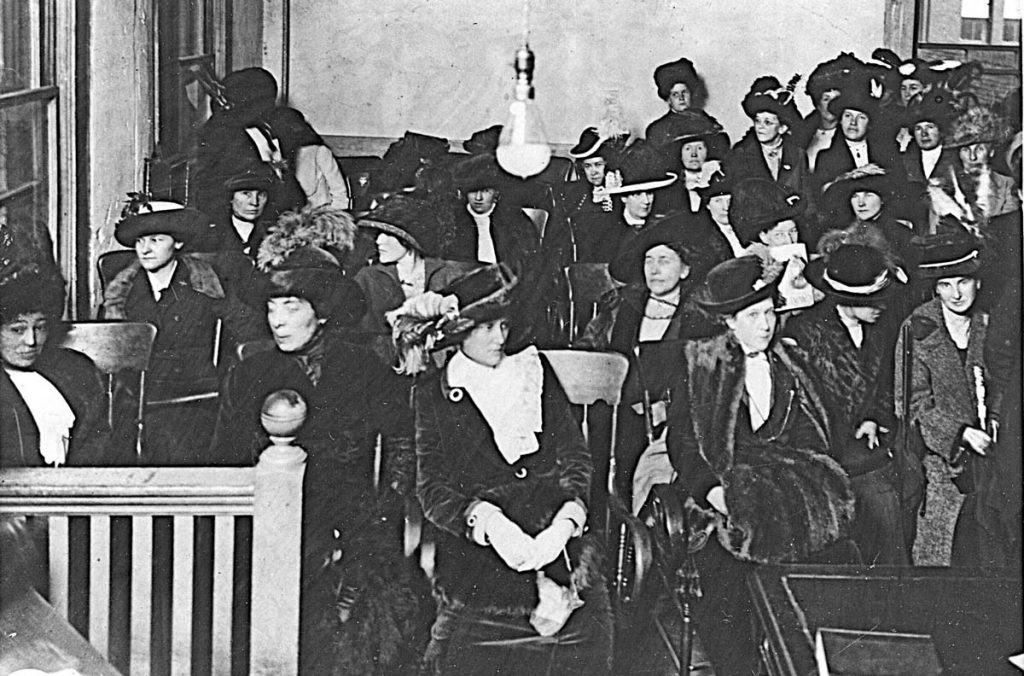Sidebar
Gender-Based Jury Exclusion

A group of women registering for jury duty in Portland, Oregon, in 1912. It was not until 60 years later that the Supreme Court found gender-based jury exclusion to be unconstitutional.
Gardiner P. Bissel/Oregon Journal
For centuries, state laws barred women from jury service on the theory that women were too fragile to participate in public life and needed protection from the “indecent” aspects of criminal trials.1 See, e.g., Bailey v. State, 219 S.W.2d 424, 428 (Ark. 1949) (“Criminal court trials often involve testimony of the foulest kind, and they sometimes require consideration of indecent conduct, the use of filthy and loathsome words, references to intimate sex relationships, and other elements that would prove humiliating, embarrassing and degrading to a lady.”); William Blackstone, Commentaries on the Laws of England Volume 2 (San Francisco: 1916), 1962 (English common law categorically excluded women from juries based on “propter defectum sexus (because not of the male sex)”). Three states—Alabama, Mississippi, and South Carolina—statutorily barred women from serving on juries well into the 1960s.2 Hoyt v. Florida, 368 U.S. 57, 62 n.5 (1961) (noting that women were eligible for jury service in all states except Alabama, Mississippi, and South Carolina) (citing Ala. Code, 1940 (Recompiled Vol. 1958), Tit. 30, s 21; Miss. Code Ann., 1942 (Recompiled Vol. 1956), s 1762; S.C. Code, 1952, s 38-52).
States that did not categorically exclude women nonetheless enforced gender-based barriers to jury service, such as requiring women to register with the clerk of court if they wanted to volunteer for jury service.3 See, e.g., Fla. Stat. § 40.01(1) (1959) (“[T]he name of no female person shall be taken for jury service unless said person has registered with the clerk of the circuit court her desire to be placed on the jury list.”); La. Stat. Ann. § 15:172.1 (1950); N.H. Rev. Stat. Ann. § 500:1 (1955).
Not until 1975 did the Supreme Court determine that excluding women from jury service violates the requirement that a jury be drawn from a fair cross-section of the community.4 Taylor v. Louisiana, 419 U.S. 522 (1975). Despite this ruling, lawyers continued to use peremptory strikes to eliminate women from juries until the Supreme Court decided in 1994 that gender-based strikes violate the Fourteenth Amendment right to equal protection.5 J.E.B. v. Alabama, 511 U.S. 127 (1994).
In many states, the history of gender-based jury exclusion tracks the history of opposition to women’s suffrage.
Alabama voted against ratification of the Nineteenth Amendment in 1919 and did not officially endorse suffrage for women until 1953.6 S.J. Res. 79, 1953 Reg. Sess. (Ala. 1953) (enacted) (“Whereas this Amendment, which gives women the right to vote, has been the law of the land since August 26, 1920, and the women in our State have been voting and holding public office for many years…the Legislature desires to record its approval of extending the right of suffrage to women”). Similarly, Alabama statutorily barred women from serving on juries until 1967.7 1966 Ala. Laws 427 (Act No. 284); 1966 Ala. Laws 428 (Act No. 285 amending Section 21 of Title 30, Code of Alabama 1940, which had excluded women from jury service); see also Carter v. Jury Comm’n of Greene Cty., 396 U.S. 320, 327 (1970) (“In 1967, following a statutory amendment, the [Alabama] commission added women to the jury roll.”); White v. Crook, 251 F.Supp. 401, 409-10 (M.D. Ala. 1966) (holding Alabama’s statutory exclusion of women unconstitutional and mandating that Alabama end such exclusion by June 1, 1967). For the next 11 years, state law authorized judges to exclude women—and only women—from jury service if a good reason could be articulated.8 1966 Ala. Laws 428 (Act No. 285: “When any female shall have been summoned for jury duty she shall have the right to appear before the trial Judge, and such Judge, for good cause shown, shall have the judicial discretion to excuse said person from jury duty. The foregoing provision shall apply in either regular or special venire.”); 1978 Ala. Laws 712, enacting Ala. Code § 12-16-62 (“No qualified prospective juror is exempt from jury service.”).
This gender-based exemption systematically excluded women from juries.9 See Penn v. Eubanks, 360 F. Supp. 699, 703 (M.D. Ala. 1973) (rather than conduct hearings on gender-based exemptions from service, Alabama courts simply excluded women from jury rolls). During the early 1990s, Alabama prosecutors admitted to striking Black women from juries, explicitly stating “because she was a woman” as their rationale, which the state appellate courts accepted as a valid, race-neutral reason.10 See, e.g., Bankhead v. State, 625 So. 2d 1141, 1142 (Ala. Crim. App. 1992); Fisher v. State, 587 So. 2d 1027, 1037 (Ala. Crim. App. 1991).